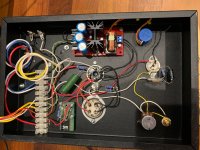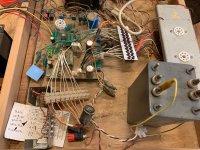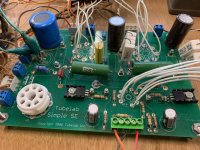My current "flex" version of the old Simple 45 circuit has provision to use 4-or-5 pin power tubes with a 417A/5842 driver under a CCS.
I'm working on a pair of 300B monoblocks to replace it (for improved WAF), but before I cannibalize it, has anyone used a 46 driver to a 300B in SE configuration?
I have a small pile of 46 tubes (as well as low power triodes like 76, 56, 71A).
I was pretty impressed with the linearity of the 46 as a power tube, just didn't have quite enuf power.
I doubt that a 46 alone has enough Mu without some input help (another stage? a step-up transformer?), but perhaps a 9-pin/46/300B arrangement?
The sockets are already in there; would just need a little rewiring...
I'm working on a pair of 300B monoblocks to replace it (for improved WAF), but before I cannibalize it, has anyone used a 46 driver to a 300B in SE configuration?
I have a small pile of 46 tubes (as well as low power triodes like 76, 56, 71A).
I was pretty impressed with the linearity of the 46 as a power tube, just didn't have quite enuf power.
I doubt that a 46 alone has enough Mu without some input help (another stage? a step-up transformer?), but perhaps a 9-pin/46/300B arrangement?
The sockets are already in there; would just need a little rewiring...
Attachments
I hacked ( literally ) an SSE board to use four and five pin directly heated power tubes.
If mu is the only consideration, I don't see how 46 can get you where you want to be. 47 should, with a bunch of mu left over.
Toward the end of this thread, you can see some crude measurements of the relative performance of each as power tubes.
47's are cheap ( or used to be - I haven't kept up with tube prices, lately ) because it seems to have no audiophile cred.
Tubelab SE: Removing MOSFETs?
If mu is the only consideration, I don't see how 46 can get you where you want to be. 47 should, with a bunch of mu left over.
Toward the end of this thread, you can see some crude measurements of the relative performance of each as power tubes.
47's are cheap ( or used to be - I haven't kept up with tube prices, lately ) because it seems to have no audiophile cred.
Tubelab SE: Removing MOSFETs?
Attachments
I did a similar hack on the RatLab "amp in a drawer" (now covered w/years of cabinet making dust) to use random octal power tubes (esp. the 6AV5) and random 8-or-9 pin twin driver tubes. Never thought to use DHTs. Hmmmm.
47s appear to have gotten moderately expensive, which is to say verging on 46 prices.
In an older post, TubeLab George mentioned the 307A as a 300B substitute.
Those seem to be reasonable for a power tube (NOS for about $150 a pair), PLUS they have the "highly desirable" top cap. (Whoa, Bubba, the goal is improved Wife Acceptance Factor...never mind.)
The Bartola Valve fellow in UK has used the 46 as a 300B driver, but following a Lundahl 1:8 step-up transformer (like you'd use on an MC phono cartridge):
300B SE Amp: 46 Driver (Part II) – Bartola(R) Valves
This gave him a gain of ~45 the hard way. Ultimately he apparently switched to the 47, as you suggested (but retained the Lundahl for some reason; low voltage source?).
I'm not opposed in any way to the 417A/5842 driver, just want to leave no stone unturned before I start cutting steel for these monoblocks.
I do have space for a "supplemental" driver socket on each monoblock; I will at least stuff an octal in there, just in case. All y'all know what I mean...
47s appear to have gotten moderately expensive, which is to say verging on 46 prices.
In an older post, TubeLab George mentioned the 307A as a 300B substitute.
Those seem to be reasonable for a power tube (NOS for about $150 a pair), PLUS they have the "highly desirable" top cap. (Whoa, Bubba, the goal is improved Wife Acceptance Factor...never mind.)
The Bartola Valve fellow in UK has used the 46 as a 300B driver, but following a Lundahl 1:8 step-up transformer (like you'd use on an MC phono cartridge):
300B SE Amp: 46 Driver (Part II) – Bartola(R) Valves
This gave him a gain of ~45 the hard way. Ultimately he apparently switched to the 47, as you suggested (but retained the Lundahl for some reason; low voltage source?).
I'm not opposed in any way to the 417A/5842 driver, just want to leave no stone unturned before I start cutting steel for these monoblocks.
I do have space for a "supplemental" driver socket on each monoblock; I will at least stuff an octal in there, just in case. All y'all know what I mean...
Attachments
In an older post, TubeLab George mentioned the 307A as a 300B substitute. Those seem to be reasonable for a power tube (NOS for about $150 a pair), PLUS they have the "highly desirable" top cap.
I'm not opposed in any way to the 417A/5842 driver, just want to leave no stone unturned before I start cutting steel for these monoblocks.
$150 for a pair of 307A's? I had over a hundred of them took them to hamfests and put them on Ebay for over 10 years and rarely sold any at $20 each. About 2 and a half years ago I bulk sold most of them in a three way deal with ESRC and another seller. Unfortunately that deal went bad. The end buyer claimed that ALL of the tubes were defective and never paid Stan. I asked that the tubes be returned to me for verification. Stan never got them back. We agreed to split the loss, with me receiving about $7.50 each in credit for tubes at ESRC. Unfortunately I never got to spend all of it. I have some 307A's left, but I don't know how many. I do plan to make a push pull amp with them someday using my Universal Driver board.
I got the 307A's and over 100,000 tubes in exchange for three or four weekends worth of manual labor that involved four 450 mile road trips to clean out the warehouse that they were in. The derelict warehouses were being demolished when someone decided that the some tubes contained mercury and declared the whole place hazmat. I took all the tubes while my buddy (a surplus dealer) took everything else.
This all occurred when I was designing the original TSE, so I stuck every potential driver tube that I had (over 100 different tubes) into a test board and took measurements as well as listened to the good ones. The 5842 was about $5 at that time, and was the best choice for a clean driver, so that's why it's in there.
There were some other decent choices, but the 5842 was the best. Old style 4 pin DHT's with enough gain to drive a 45 or worse a 300B tend to be microphonic, so you may have to isolate it from vibrations.
Slap that board in the dishwasher, and it'll look like new.
I laughed when you said that, but after exploding the second electrolytic in my personal test SSE, I tried it. The ugly board became far less ugly.
NOTES: Do this when your wife is not home. Don't use dishwasher detergent, It's rather nasty stuff and tends to corrode stuff. I had already scrubbed down my board with a toothbrush and WD-40 several times after blowing parts, so it was a bit sticky with a slime consisting of electrolytic goo, WD-40, and dust. I drenched it in rubbing alcohol and put in the dishwasher with no detergent. That was probably 10 years ago. The first two pictures show what it looked like last year. It's been living in a box with a bunch of other rarely used boards so it has gained some new dust. I only use it for experiments that may end badly. It was originally build 15 years ago when I got the first batch of SSE boards and built 5 of them for testing.
In another surplus deal I got a sealed box of NOS Sylvania 6V6GTA from a storage locker at the NASA facility in Cape Canaveral. I was disappointed to find that many of the tubes had gone to air despite being in a climate controlled facility. I tossed them and kept the rest. Later I found that more had turned white. Today only about 15 of the 100 tubes are usable, and I will not trust them in an amp. Back when I opened the box I got angry at the dead tubes and decided to make some "deader." This is how the first electrolytic exploded.
The poor board also got to "test" some "NOS" tubes that turned out to be not so NOS. They lived their remaining life rather quickly. The board did not blow during this test Those poor little tubes were playing music at about 15 watts per channel for about half an hour when one tube decided to go into runaway. I cut power to avoid a blown cap.
The same board was also used for the clip lead furball that led to a SPUD board design.
Attachments
-
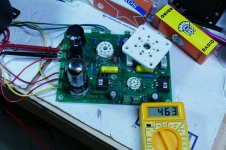 P3730214_x.jpg700.6 KB · Views: 162
P3730214_x.jpg700.6 KB · Views: 162 -
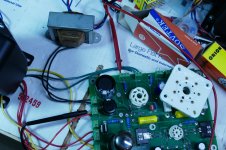 P3730215_x.jpg807 KB · Views: 161
P3730215_x.jpg807 KB · Views: 161 -
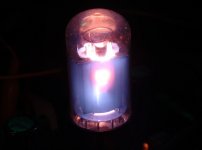 Tube_2C.jpg158.2 KB · Views: 66
Tube_2C.jpg158.2 KB · Views: 66 -
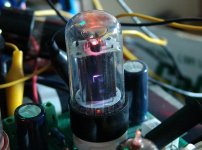 Tube_1A.jpg279.8 KB · Views: 72
Tube_1A.jpg279.8 KB · Views: 72 -
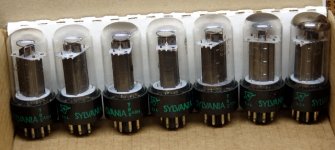 LineUP.jpg162.5 KB · Views: 168
LineUP.jpg162.5 KB · Views: 168 -
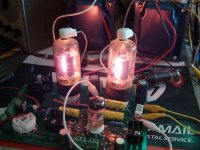 6BQ6GA.jpg228.4 KB · Views: 74
6BQ6GA.jpg228.4 KB · Views: 74 -
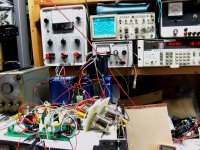 Working_Setup.jpg336.4 KB · Views: 70
Working_Setup.jpg336.4 KB · Views: 70 -
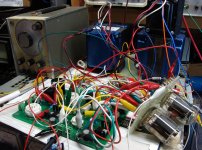 Furball_board_2.jpg338.7 KB · Views: 51
Furball_board_2.jpg338.7 KB · Views: 51 -
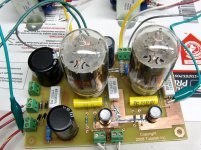 Spud_Board_1.jpg311 KB · Views: 55
Spud_Board_1.jpg311 KB · Views: 55
Sell a Kidney, PLUS "one last question" (snort)
So I guess it's come time to Sell a Kidney, I mean, Buy a Bunch of 5842s.
I shouldn't complain; $20-30 bucks to drive an $80-100 300B isn't bad, RELATIVELY.
I found the PowerDrive pages, which pretty well explain the (wacky) bias arrangement on either side of the MOSFET. I have a handful of nice Bourns 100K 10-turn pots which give an exaggerated impression of precision, so that's good.
One "final" question about my Simple 300B monoblocks:
I have a 10 ohm resistor grounding one leg of the 5V filament supply*, which is intended as a fuse/failsafe against runaway.
HOWEVER, I just noticed that I got 10 ohms by paralleling two 20 ohm 1-watt resistors, and realized that
(a) don't even know if runaway protection is required in the MOSFET circuit (it isn't in the TSE), and
(b) if it IS required, what wattage to use to have the cathode resistors act like a fuse; certainly 2x1 watt is likely too big, or
(c) should I just use an actual FUSE, say 200mA?
(* I happen to be using Pete Millett's filament supply board with the Common Mode choke, but otherwise same-same)
So I guess it's come time to Sell a Kidney, I mean, Buy a Bunch of 5842s.
I shouldn't complain; $20-30 bucks to drive an $80-100 300B isn't bad, RELATIVELY.
I found the PowerDrive pages, which pretty well explain the (wacky) bias arrangement on either side of the MOSFET. I have a handful of nice Bourns 100K 10-turn pots which give an exaggerated impression of precision, so that's good.
One "final" question about my Simple 300B monoblocks:
I have a 10 ohm resistor grounding one leg of the 5V filament supply*, which is intended as a fuse/failsafe against runaway.
HOWEVER, I just noticed that I got 10 ohms by paralleling two 20 ohm 1-watt resistors, and realized that
(a) don't even know if runaway protection is required in the MOSFET circuit (it isn't in the TSE), and
(b) if it IS required, what wattage to use to have the cathode resistors act like a fuse; certainly 2x1 watt is likely too big, or
(c) should I just use an actual FUSE, say 200mA?
(* I happen to be using Pete Millett's filament supply board with the Common Mode choke, but otherwise same-same)
Say, George: Did you ever find operating points at which the 6BQ6 sounded good?
I tried them (in the RatLab set-up) but never found a way to make them work well, but perhaps I was too conservative (as happened with the 6AV5).
They sure were cute, though, with their slim tube and jaunty top-cap.
I tried them (in the RatLab set-up) but never found a way to make them work well, but perhaps I was too conservative (as happened with the 6AV5).
They sure were cute, though, with their slim tube and jaunty top-cap.
I use a 0.25 watt 10 ohm resistor in the center tap of the AC heated cathodes of my DHT SSE to read current. It doesn't even get warm.
If you want to use one as a fuse, 0.125 ( 1/8 ) watt might still be too big. I'm not sure there are any lower wattage leaded part.
If you are using dc on the filaments, a 1/8 watt resistor in the plate lead might provide some protection, but a fuse would be better. There's just not enough voltage drop across such a small resistance.
If you want to use one as a fuse, 0.125 ( 1/8 ) watt might still be too big. I'm not sure there are any lower wattage leaded part.
If you are using dc on the filaments, a 1/8 watt resistor in the plate lead might provide some protection, but a fuse would be better. There's just not enough voltage drop across such a small resistance.
Last edited:
Re: fused cathode
I put the 10 ohms down there for the same reason, but apparently didn't have 20 ohm resistors below 1W at the time. Typically I stock 1/2W and above (very little Sand work), so not surprising.
I struggle to imagine the scenario where a 300B under Power Drive (i.e. with CCS on the drive and the MOSFET on the grid) COULD run-away, but that could be a failure of knowledge and/or imagination.
Re: Dishwasher
Hey, kids, don't explode electrolytics and you won't need to put your circuit boards thru Mommy's dishwasher!
Turns-out cabinet-making dust comes off with a chip brush and the Fine Nozzle on the FEIN shopvac.
Note the tiny soldered-in screw terminals for changing components. I use these a lot, even soldered to snap-in cap leads, for example.
The RatLab set-up was pretty good (poor-boy cousin of George's plastic pegboard set-up) but I need a new drawer, maybe with a cover so I can store it on my shop shelves.
I put the 10 ohms down there for the same reason, but apparently didn't have 20 ohm resistors below 1W at the time. Typically I stock 1/2W and above (very little Sand work), so not surprising.
I struggle to imagine the scenario where a 300B under Power Drive (i.e. with CCS on the drive and the MOSFET on the grid) COULD run-away, but that could be a failure of knowledge and/or imagination.
Re: Dishwasher
Hey, kids, don't explode electrolytics and you won't need to put your circuit boards thru Mommy's dishwasher!
Turns-out cabinet-making dust comes off with a chip brush and the Fine Nozzle on the FEIN shopvac.
Note the tiny soldered-in screw terminals for changing components. I use these a lot, even soldered to snap-in cap leads, for example.
The RatLab set-up was pretty good (poor-boy cousin of George's plastic pegboard set-up) but I need a new drawer, maybe with a cover so I can store it on my shop shelves.
Attachments
- Status
- This old topic is closed. If you want to reopen this topic, contact a moderator using the "Report Post" button.
- Home
- More Vendors...
- Tubelab
- 46 driver for 300B Simple SE?
